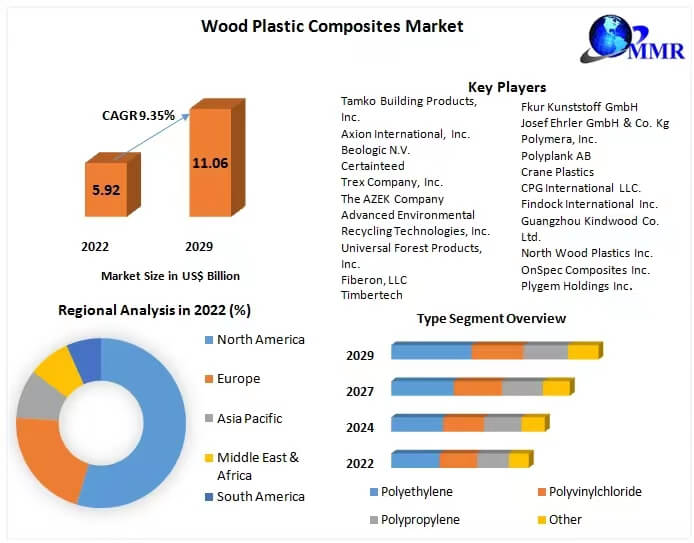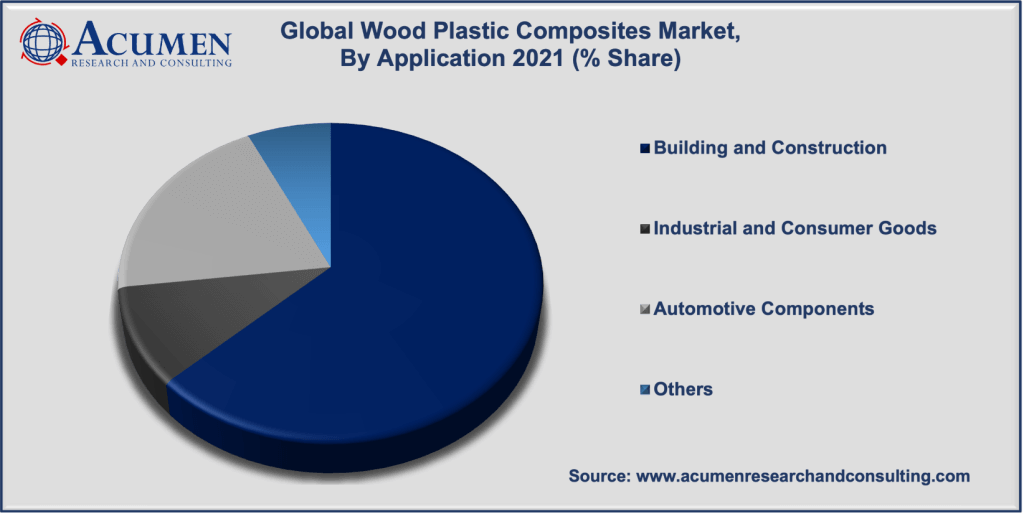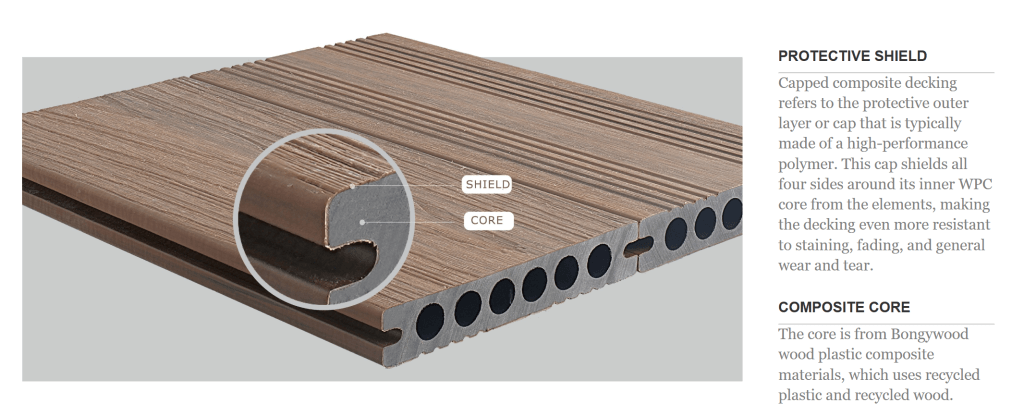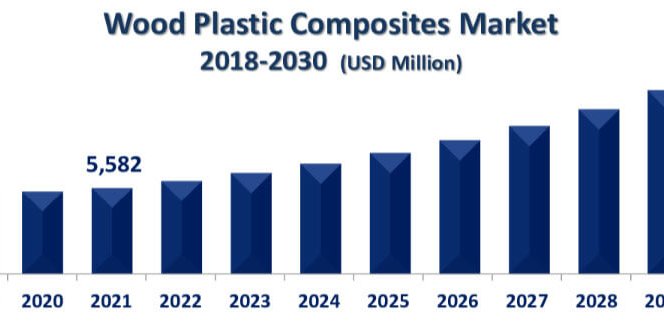The global trends in wood plastic composites (WPC) market is experiencing remarkable growth, with projections indicating a market size of US$ 11.06 billion by the end of 2029, accompanied by a robust compound annual growth rate (CAGR) of 9.35%. North America has established itself as the largest market for wood-plastic composites, while the Asia-Pacific region is expected to witness the highest CAGR during the forecast period.

Applications
WPCs find extensive application in the building and construction sector, notably in decking, moulding and trimming, fencing, landscaping, and outdoor applications. Additionally, the material is making inroads into automotive components, industrial and consumer goods, furniture, and various other applications, showcasing its versatility and adaptability across industries.
Outdoor applications for WPC:
- Non-load-bearing/non-structural applications in the building sector, especially decking, siding, railings, window frame construction, porches and docks
- Wood in the garden: garden furniture, fences and other applications in the garden
- Noise barriers in street construction and sheet pilings for landscaping
Indoor applications for WPC
- Automotive engineering (interior trim), “under the hood” covering and parts exposed to less than 110°C
- Trucks and containers (e.g. loading platforms)
- Doors (frames and profiles), furniture parts (cupboard legs, kitchen cupboard frames etc.), chairs, window sills
- Boards as a replacement for MDF and particle board in areas of high humidity

Material Composition
Wood-plastic composites (WPCs) are becoming increasingly popular as a versatile and sustainable alternative to traditional materials like wood, plastic, and metal. WPCs are made from a combination of wood fibers and thermoplastic resins, which provides them with the desirable properties of both materials: the strength and durability of wood, and the workability and low maintenance of plastic. The increasing demand for recyclable and biodegradable materials is expected to be a driving force behind the sustained growth of the WPC market.
The trend of sustainable composite decking:
Composite decking is also becoming more sustainable. Many manufacturers are now using recycled materials in their composite decking products.
The trend of capped composite decking:
Another trend in the composite decking market is the increasing popularity of capped composite decking. Capped composite decking has a thin layer of polymer that protects the decking from scratches, stains, and fading.
Capped composite decking is more expensive than traditional composite decking, but it is also more durable and easier to maintain.

Future of the composite decking market
The composite decking market is expected to continue to grow in the coming years. This growth will be driven by the increasing demand for low-maintenance, durable, and sustainable decking materials. Wood Plastic Composites Market, by Region:
North America (United States, Canada and Mexico)
- North America is a mature market for WPCs, but it is still expected to grow at a CAGR of 3.5% between 2023 and 2028. The United States is the largest market for WPCs in North America.
Asia Pacific (China, South Korea, Japan, India, Australia, Indonesia, Malaysia, Vietnam, Bangladesh, Pakistan and Rest of APAC)
- Asia-Pacific: This is the second-largest and fastest-growing market of WPC, with a CAGR of over 12% from 2023 to 2030. The market is driven by the rapid urbanization, industrialization, and population growth in the region, especially in China, India, Japan, and South Korea. These countries have a huge demand for WPC products in the building and construction, automotive, and consumer goods sectors. The market is also supported by the availability of low-cost raw materials, such as wood waste and agricultural residues, and the increasing environmental awareness and regulations in the region.
Europe (UK, France, Germany, Italy, Spain, Sweden, Austria and Rest of Europe)
- Europe: This is the third-largest market of WPC, with a CAGR of over 9% from 2023 to 2030. The market is driven by the high demand for WPC products in the building and construction, automotive, and furniture sectors in the region, especially in Germany, France, the United Kingdom, and Italy. The market is also influenced by the stringent environmental policies and standards in the region, such as the European Union’s Circular Economy Action Plan and the Green Deal, which promote the use of recyclable and biodegradable materials.
Middle East and Africa (South Africa, GCC, Egypt, Nigeria and Rest of ME&A)
- Middle East and Africa: This is the smallest and slowest-growing market of WPC, with a CAGR of over 6% from 2023 to 2030. The market is driven by the increasing demand for WPC products in the building and construction, automotive, and consumer goods sectors in the region, especially in Saudi Arabia, the United Arab Emirates, South Africa, and Egypt. The market is also supported by the rising disposable income, urbanization, and tourism in the region, which create opportunities for the development of infrastructure and amenities.
South America (Brazil, Argentina Rest of South America)
- South America: This is a relatively small but emerging market of WPC, with a CAGR of over 8% from 2023 to 2030. The market is driven by the increasing demand for WPC products in the building and construction, automotive, and industrial sectors in the region, especially in Brazil, Argentina, and Chile. The market is also boosted by the availability of abundant natural resources, such as wood and agricultural waste, and the growing awareness and adoption of green building practices in the region.
Future Outlook
WPCs are expected to continue to grow in popularity in the coming years, driven by their sustainability, durability, and versatility. The global WPC market is expected to reach USD 20 billion by 2030, with a CAGR of 9.2%. This growth will be supported by increasing demand for sustainable materials, rising construction activity, and growing adoption in new applications.
Reference:
Wood Plastic Composites Market Analysis – Global Industry Size, Share, Trends and Forecast 2022 – 2030
Wood Plastic Composites Market – Global Industry Analysis and Forecast (2023-2029)
Bongywood Wood Plastic Composite
Guangdong Bongywood New Building Materials Co., Ltd. is a professional manufacturer specializing in the R&D, production, and sales of WPC (Wood Plastic Composite) materials, our products include composite decking, capped composite decking, WPC Wall Panel, WPC Railing & Fencing, WPC Pergola & Gazebo, WPC Chairs & Bench, WPC Flower Planter Pots, etc.
Leave a Reply



